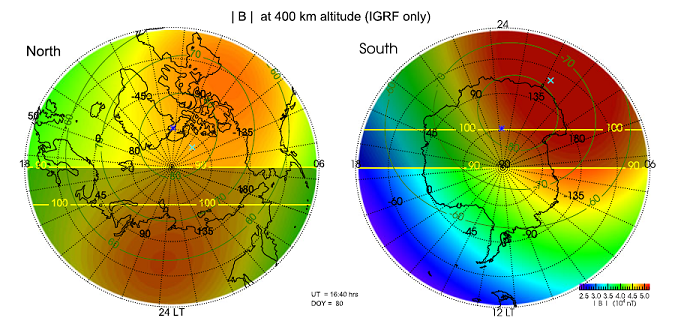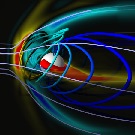Abstract
Disturbances in the solar wind and interplanetary magnetic field (IMF) affect the Earth's high-latitude thermosphere and ionosphere via coupling with the magnetosphere. To first order, one might expect these coupling processes to be symmetric between the two hemispheres. However, recent observations have shown that the upper thermospheric/ionospheric response to solar wind and IMF dependent drivers of the magnetosphere-ionosphere-thermosphere system can be very dissimilar in the Northern (NH) and Southern Hemisphere (SH).
Statistical studies of both ground- and satellite-based observations show hemispheric differences in the average high-latitude electric field patterns, associated with magnetospheric convection, as well as hemispheric differences in ion drift and neutral wind circulation patterns. The cross-polar neutral wind and ion drift velocities are generally larger in the NH than the SH, and the hemispheric difference shows a semi-diurnal variation. The neutral wind vorticity is likewise larger in the NH than in the SH, with the difference probably becoming larger for higher solar activity. In contrast, the spatial variance of the neutral wind is considerably larger in the SH polar region.
Simulations with the Coupled Magnetosphere-Ionosphere-Thermosphere (CMIT) model have recently demonstrated that these differences can be explained at least to some extent by asymmetries in the Earth's magnetic field, both in magnetic flux density and in the offset between the geographic and invariant magnetic poles in the two hemispheres (see figure 1 below). However, the effects of this magnetic field asymmetry on the high-latitude thermosphere and ionosphere have to be investigated more systematically. In particular, the dependence of hemispheric asymmetries on altitude, season, IMF conditions, and solar activity level are not yet understood.
The goal of this team is to study various aspects of hemispheric asymmetries through a combination of numerical model simulations and analyses of observations obtained with different methods, covering different spatial and temporal ranges. The proposed work is highly timely considering the recent launch of the Swarm mission, which will provide further observational material for our project.

Figure 1. Geomagnetic flux density |B| at 400 km altitude for the present era over the Northern (left) and Southern (right) polar regions, shown as colour-coded contour plots with the same scale (bottom right), according to the International Geomagnetic Reference Field (IGRF). The geomagnetic poles (associated with the best-fitting dipole) are indicated with dark-blue asterisks and the magnetic poles (or dip pole positions) with light-blue crosses. The green isolines show geomagnetic parallels of altitude-adjusted corrected geomagnetic coordinates (AACGM). The yellow solar zenith angle lines and the shading illustrate the solar illumination during equinox at 16:40 UT.
